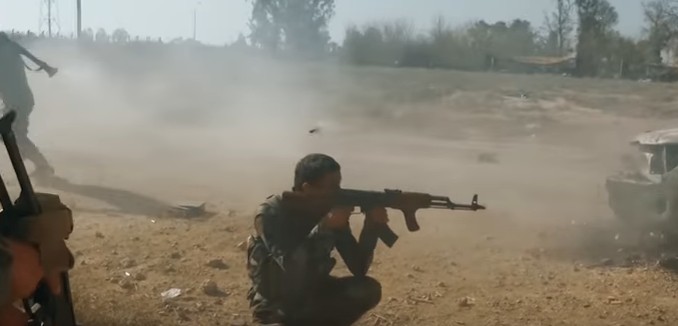Tomorrow, Israeli Prime Minister Benjamin Netanyahu is set to meet Russian President Vladimir Putin to discuss events in southwestern Syria. Netanyahu has already released a statement in advance of the meeting declaring that Israel “will not tolerate the establishment of a military presence by Iran and its proxies anywhere in Syria – not close to the border and far away from it.”
This is only the first of two crucial upcoming meetings involving Putin and Russia’s Syria policy. Next Monday, Putin is scheduled to meet American President Donald Trump as well, with Syria reported to be at the top of the agenda.
Russia’s role in Syria is especially pertinent now because the Kremlin is currently leading a blistering Assad regime offensive against Syrian opposition areas in the province of Daraa, which borders Israel and Jordan. After some 250 civilians were killed and over 350,000 displaced, pro-regime forces have forced rebels to relinquish control of the Syrian-Jordanian borders in the east of the province. It is likely that Putin’s next series of meetings aims to secure support for a similar attack on west Daraa, which borders Israel and is now packed with displaced persons who have fled recent regime advances.
According to widespread reports, both Trump and Netanyahu assented to the Russian offensive on east Daraa on the premise that Russia would ensure Iranian proxies – many of whom have declared their intention to attack Israel – did not participate. If so, Trump and Netanyahu must rethink their approach.
On May 30, Russian Foreign Minister Sergei Lavrov declared that all “non-Syrian” forces must leave southwest Syria, and withdrawals of Iranian proxies were observed soon thereafter. It was later revealed, however, that the Iranian proxy Hezbollah had simply switched to regime uniforms to avoid airstrikes. Three weeks later, reports again emerged of a withdrawal by Iran and its proxies from the buffer zone reportedly desired by Israel. This cued the start of Russian airstrikes on Daraa and the beginning of the Assad regime’s offensive in earnest. But here, too, Iran’s withdrawal was a ruse.
The Foundation for Defense of Democracies confirmed the involvement of Iranian proxy “Liwa Zulfikar” in the attack on Daraa on June 27, only four days after Russian airstrikes began. This involvement enabled the regime side to make its first major advances of the offensive. The following week, as east Daraa began to fall and the regime increasingly set its sights on the west of the province, an Iranian proxy force was again spotted on the hottest frontline – this time, it was the “Abu Fadel al-Abbas” brigade operating in Da’el town, just 28 km (17.5 miles) from Israel and well within Israel’s desired buffer.
It is hard to imagine that Russia could provide heavy air support to Iranian proxies in multiple key frontlines without realizing it. But just in case there was any doubt, an explosive photograph emerged from Da’el on July 3 that purported to show “Abu Fadel al-Abbas” leader “Abu Ajeeb” speaking with a Russian general at a site he had repurposed into a military base. If all the claims associated with this photograph are true, it means that Russia is playing a treacherous double game, working directly with Iranian proxies on the ground even as it tells America and Israel that it is seeks for their removal.
For the first time, I wish to share my process for verifying the information in the photograph. While “Abu Ajeeb’s” physical appearance is well-known and the Slavic facial features of his interlocutor are obvious, the key step of verification in this case is to confirm the location. Since the opposition controlled Da’el from virtually the start of the armed conflict – long before the “Abu Fadel al-Abbas” militia existed – until the current offensive, any photograph from Da’el would have to be quite recent.
I am in contact with a number of Syrian opposition members from Daraa, who identified the exact location of this photograph as the “Martyr Fayz al-Jamous” school. This location, in the northwest of Da’el, is currently on a front line and is thus a reasonable site to choose as a base. Furthermore, by comparing an overhead satellite image of the school with information available in the shared photograph, I identified that the shared photograph is consistent with a photo taken at the west corner of the school courtyard, facing northwest.
This imagery analysis confirms, at a minimum, that Russian forces on the ground in southwest Syria are aware that Iranian proxies are operating within Israel’s desired 40-km buffer zone. While Russian president Putin claims that Russian mercenaries are present in Syria without his knowledge or permission, a growing body of evidence shows that this claim is not really credible.
I have studied Iran’s proxies for years and previously published a detailed study in The Tower on major war crimes carried out by them. The “Zulfikar Brigade” is behind a massacre of over 200 civilians in the town of Nabk, while “Abu Fadel al-Abbas” carried out one of the largest mass rapes of the war at the gates of the capital Damascus.
Russia knows that it is conducting airstrikes on behalf of brutal militias like these, who are behind mass atrocities and widespread sectarian cleansing that has played no small role in the Syrian refugee crisis. Russia knows that these militias, who have clear designs against Israel, are now approaching the Israeli border.
Trump and Netanyahu should hold Putin’s feet to the fire about these Russian actions and broken promises to remove Iranian proxies during their meetings on Syria in the coming days.
[Photo: انشودة فخر الكتائب | المنشد اللبناني نصرت سلامة |2017 -2018 HD / YouTube ]




